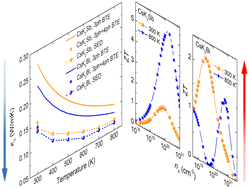Antibonding induced anharmonicity leading to ultralow lattice thermal conductivity and extraordinary thermoelectric performance in CsK2X (X = Sb, Bi)†
Abstract
Full Heusler compounds have long been discovered as exceptional n-type thermoelectric materials. However, no p-type compounds could match the high n-type figure of merit (ZT). In this work, based on first-principles transport theory, we predict the unprecedentedly high p-type ZT = 2.2 at 300 K and 5.3 at 800 K in full Heusler CsK2Bi and CsK2Sb, respectively. By incorporating the higher-order phonon scattering, we find that the high ZT value primarily stems from the ultralow lattice thermal conductivity (κL) of less than 0.2 W mK−1 at room temperature, decreased by 40% compared to the calculation only considering three-phonon scattering. Such ultralow κL is rooted in the enhanced phonon anharmonicity and scattering channels stemming from the coexistence of antibonding-induced anharmonic rattling of Cs atoms and low-lying optical branches. Moreover, the flat and heavy nature of valence band edges leads to a high Seebeck coefficient and moderate power factor at optimal hole concentration, while the dispersive and light conduction band edges yield much larger electrical conductivity and electronic thermal conductivity (κe), and the predominant role of κe suppresses the n-type ZT. This study offers a deeper insight into the thermal and electronic transport properties in full Heusler compounds with strong phonon anharmonicity and excellent thermoelectric performance.



 Please wait while we load your content...
Please wait while we load your content...